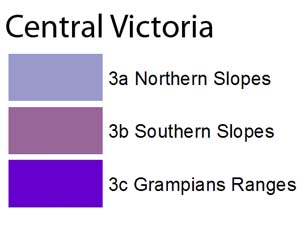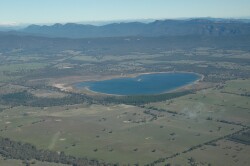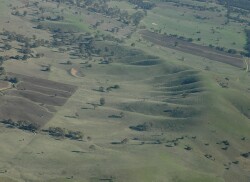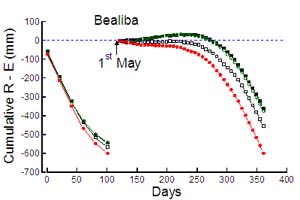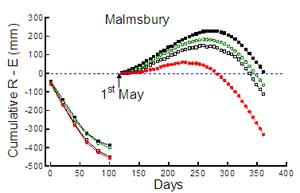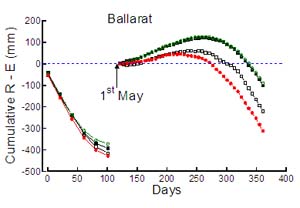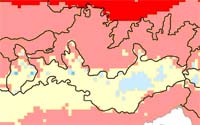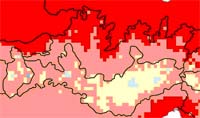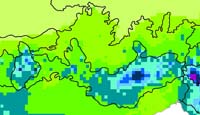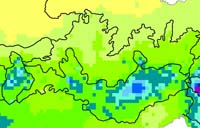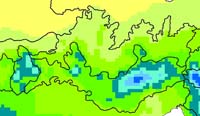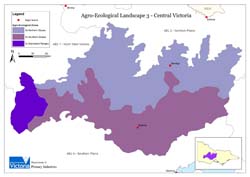Primary Production Landscapes Home
Primary Production Landscapes
Northern Slopes
The Northern Slopes receive less rainfall, and experience higher solar radiation and evaporation than Southern Slopes. Mixed farming land uses includes grazing and cropping.
Southern Slopes
The Southern Slopes receive significantly higher rainfall and experience less evaporation from coastal climatic influences than Northern Slopes. Grazing and cropping are main land uses of texture contrast soils with low inherent fertility.
Grampians Ranges
The Grampians Ranges are mainly national park with steep slopes and sandy soils. Rainfall here is significantly higher than for the Northern Slopes. | |
Management practices and issues in response to Climate Change
Mixed farming systems - North
- Cultivation tillage was the accepted management practice for dryland cropping when wet winters occurred in the past. Minimum tillage and no-till systems have achieved improved yields compared to conventional tillage practices.
- Opportunistic cropping and fodder production occur with favourable seasonal conditions.
- Prime lamb production is increasing and wool decreasing as producers introduce lucerne into their farming system. Fewer annual pasture systems are used with perennial pastures replacing these. Increased cereal cropping has also increased feed-lotting of prime lambs due to increased grain production and less land available for grazing.
- A greater emphasis is placed on crop selection with preference for cereals and a movement away from canola in crop-pasture rotations.
- Overall grain protein levels have increased while yields have decreased in drier seasons.
| |
Mixed farming systems - South
- Prime lambs are favoured over wool in mixed farming systems.
- Livestock (sheep and cattle) are generally in better health in response to increased winter pasture growth.
- Sheep flocks (mainly wool) have been reduced to a core breeding base to allow greater flexibility in farming for seasonal conditions. Supplementary feeding of livestock is more widespread with feed shortages experienced in autumn and winter.
- Decision-making by producers today is largely governed by seasonal climatic conditions and market pressures.
- Changes in seasonal conditions and increased winter growth have provided opportunities to trigger systems that include cropping and grazing.
- A distinct change in climate has been observed with a shorter growing season and hotter summers (semi-Wimmera environment). An increase in proportion of cropping in mixed farming systems has resulted.
- Pressures on perennial pasture systems have greatly increased through less available soil moisture, frosts and heavy grazing by livestock in response to pasture shortages.
- Waterlogging and poor winter growth is less of an issue, than in the past in grazing and pasture production.
- Labour shortages are occurring in response to competition for labour by mining. This impact is significant in mixed farming systems that are labour intensive.
- Irrigation in mixed farming systems has reduced due to water shortages.
| |
Future scenarios for farming systems
- Competition for inputs (fertilisers, sprays and seeds) appears to be increasing and driving up prices. Implications of adoption and uptake for genetically modified crops remain unknown.
- Emphasis on integration of cropping and grazing in mixed farming. Systems biased towards cropping may experience crop failures that may curtail growth in grains production. Continued increase in prime lamb and decline in wool production is expected.
- Stocking rates are likely to decline with decreased dry matter production in pasture systems and supplementary grain shortages.
- Need to develop shorter season perennial pasture species to suit future climatic conditions.
Victoria’s changing climate
Growing Season Cumulative Rainfall minus Evaporation (four scenarios from past records)
Mean annual temperature (two scenarios from past records and one predicted scenario)
1970-1995 | 1996-2005 | 2050 A1FI prediction |
| | |
|
Mean annual rainfall (two scenarios from past records and one predicted scenario)
1970-1995 | 1996-2005 | 2050 A1FI prediction |
| | |
|
